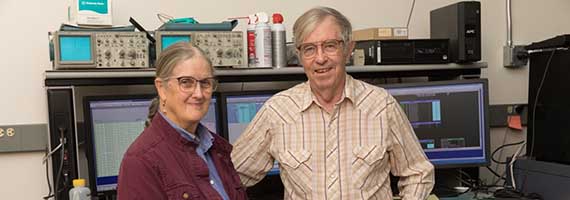
NASA honors UArizona Regents Professors, alumna for contributions to space exploration and astronomy
University of Arizona Regents Professors Marcia and George Rieke have each been recognized with NASA Distinguished Public Service Medals for their contributions to the field of astronomy and their key roles in the development of cutting-edge instruments for NASA's James Webb Space Telescope, or JWST.
The medals, awarded this month, are the highest distinction the agency bestows upon nongovernmental personnel.
In addition to the Riekes, UArizona alumna Jane Rigby, who serves as the operations project scientist for JWST, was honored with the NASA Exceptional Scientific Achievement Medal for her scientific contributions and leadership. Rigby, who graduated with a doctorate in astronomy from UArizona in 2006, has played a pivotal role in the successful transition of JWST from commissioning to routine science observations. Her work at NASA's Goddard Space Flight Center has been crucial to ensuring the seamless operation of the space observatory.
Marcia Rieke – as the principal investigator who led the development of JWST's Near Infrared Camera, or NIRCam – has demonstrated unparalleled dedication and leadership, according to her nomination for the medal. The NIRCam project, considered the most challenging instrument development effort in the JWST program, proved to be 10 times more complex than initially anticipated.
In his capacity as the science team lead for JWST's Mid-Infrared Instrument, or MIRI, George Rieke has been instrumental in facilitating international collaboration among 10 European countries and NASA's Jet Propulsion Laboratory in Pasadena, California.
Over the course of five decades with the UArizona Lunar and Planetary Laboratory and Steward Observatory, the Riekes, a husband-and-wife research team, helped the field of infrared astronomy – once a niche endeavor fraught with extreme technical challenges – flourish into a powerful discipline that has allowed scientists to see the universe in ways that were once deemed impossible.
Marcia Rieke's unwavering focus, diligence and hands-on approach in the face of formidable technical and programmatic challenges set a remarkable example for her peers, according to the award notification from NASA. In addition to her work on NIRCam, she has made significant contributions as the deputy principal investigator for the Near Infrared Camera and Multi-Object Spectrometer, or NICMOS, on the Hubble Space Telescope and as a co-investigator on the Multiband Imaging Photometer instrument, or MIPS, on the Spitzer Infrared Space Telescope. Her influential role in advancing the field of infrared astronomy is widely recognized.
With JWST, Marcia Rieke hopes to discover the most distant and therefore earliest and youngest galaxies in the universe, and trace how they changed over time. She also researches the atmospheres of exoplanets – planets outside of the solar system –to understand what they are made of.
"After so many years of anticipation, finally seeing galaxies at an age of only a few hundred million years after the Big Bang has been the culmination of my career," she said. "Seeing the happy faces of my team says it all."
George Rieke played a vital role in coordinating the construction of the MIRI instrument, successfully uniting diverse teams. His award citation highlights his exceptional leadership, visionary approach and willingness to collaborate beyond his official responsibilities, acting as the "U.S. PI (principal investigator) for MIRI." He has also made significant contributions to infrared astronomy as the principal investigator for Spitzer's MIPS instrument.
George Rieke says he is excited about JWST's capabilities to look at the evolution of the central massive black holes in galaxies. By combining previous radio, optical, ultraviolet and X-ray observations with those from JWST, his team is looking for elusive, very young black holes that are likely to be deeply shrouded in gas and dust that absorbs nearly all their output and emits it in the infrared where MIRI can find them. His team is also exploring small bodies, such as asteroids, in planetary systems outside of our solar system.
"It is so exciting not just for me but for our entire research group to see so many aspects of astronomical sources that were completely out of reach to us before the launch of JWST," George Rieke said. "It took 50 years to make this happen, but what a fantastic reward."
Rigby is known for her groundbreaking research on using gravitational lensing to study galaxies in the early universe. This work, which originated during her doctoral studies at UArizona, has continued through her leadership of the JWST project TEMPLATES, which stands for Targeting Extremely Magnified Panchromatic Lensed Arcs and their Extended Star Formation. TEMPLATES leverages JWST's Near-Infrared Spectrograph and MIRI to obtain high-resolution spectral images of gravitationally lensed galaxies. This allows Rigby and her team to construct images of early-universe galaxies that are much more detailed than what would be possible to observe with conventional imaging techniques.
Rigby's achievements have garnered numerous accolades, including the NASA Robert H. Goddard Award for Exceptional Achievement for Science, Nature's 10 Ones to Watch in 2022, BBC's 100 Women and other honors. She also had the honor of presenting and explaining the first JWST results to President Joe Biden.
"All of us at Steward Observatory are incredibly happy that NASA is recognizing Marcia, George and Jane for their major contributions to JWST," said Buell T. Jannuzi, director of Steward Observatory and head of the Department of Astronomy. "By recognizing their achievements, NASA is also recognizing the teams these three amazing individuals have formed, developed and sustained throughout the years it took to develop, launch and commission JWST. We are looking forward to celebrating with George and Marcia once they receive their medals at Goddard Space Flight Center."

For Public
Public events include our Monday Night Lecture Series, world-reknowned Astronomy Camp and Mt Lemmon Sky Center.

For Students
A good place to start if you want to become an undergrad major or grad student, or need to find our schedule of classes.

For Scientists
Find telescopes and instruments, telescope time applications, staff and mountain contacts, and faculty and staff scientific interests.




